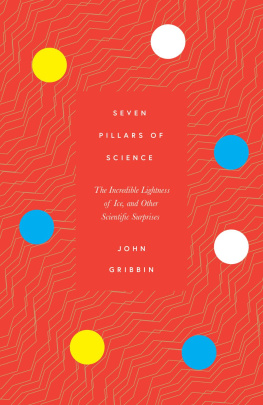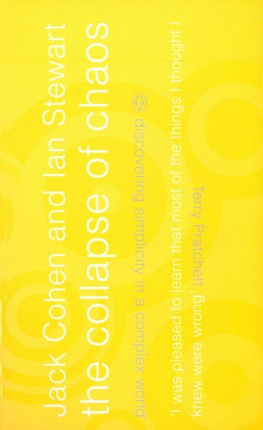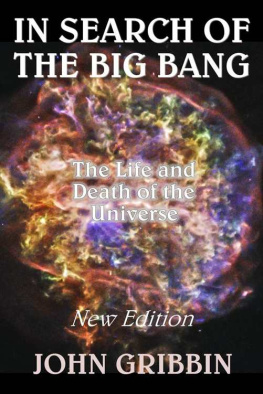JOHN GRIBBIN
Deep Simplicity
Chaos, Complexity and the Emergence of Life

PENGUIN BOOKS
PENGUIN BOOKS
Published by the Penguin Group
Penguin Books Ltd, 80 Strand, London WC2R 0RL, England
Penguin Group (USA) Inc., 375 Hudson Street, New York, New York 10014, USA
Penguin Books Australia Ltd, 250 Camberwell Road, Camberwell, Victoria 3124, Australia
Penguin Books Canada Ltd, 10 Alcorn Avenue, Toronto, Ontario, Canada M4V 3B2
Penguin Books India (P) Ltd, 11, Community Centre, Panchsheel Park, New Delhi 110 017, India
Penguin Books (NZ) Ltd, cnr Airborne and Rosedale Roads, Albany, Auckland 1310, New Zealand
Penguin Books (South Africa) (Pty) Ltd, 24 Sturdee Avenue, Rosebank 2196, South Africa
Penguin Books Ltd, Registered Offices: 80 Strand, London WC2R ORL, England
www.penguin.com
First published by Allen Lane 2004
Published in Penguin Books 2005
11
Copyright John and Mary Gribbin, 2004
All rights reserved
The moral right of the author has been asserted
Except in the United States of America, this book is sold subject to the condition that it shall not, by way of trade or otherwise, be lent, re-sold, hired out, or otherwise circulated without the publishers prior consent in any form of binding or cover other than that in which it is published and without a similar condition including this condition being imposed on the subsequent purchaser
ISBN: 978-0-14-104221-3
For Jim Lovelock
It always bothers me that, according to the laws as we understand them today, it takes a computing machine an infinite number of logical operations to figure out what goes on in no matter how tiny a region of space, and no matter how tiny a region of time. How can all that be going on in that tiny space? Why should it take an infinite amount of logic to figure out what one tiny piece of space/time is going to do? So I have often made the hypothesis that ultimately physics will not require a mathematical statement, that in the end the machinery will be revealed, and the laws will turn out to be simple, like the chequer board with all its apparent complexities.
Richard Feynman
The Character of Physical Law
The simplicity of nature is not to be measured by that of our conceptions. Infinitely varied in its effects, nature is simple only in its causes, and its economy consists in producing a great number of phenomena, often very complicated, by means of a small number of general laws.
Pierre Laplace
17491827
Contents
List of Illustrations
Acknowledgements
As with all my books, Mary Gribbin played a significant role in ensuring that the ideas presented here are intelligible to someone with no background in science. Her name would appear as co-author on the front of the book if it were not for the prejudice of our editor at Penguin against joint authorship.
We are grateful to the University of Sussex for providing a base with access to an excellent library and high-speed internet access, and to the Alfred C. Munger Foundation for a financial contribution towards our research and travel expenses.
The author and publishers are grateful to the following for permission to reproduce artwork:
courtesy Jim Lovelock.
Every effort has been made to trace all copyright holders, and the author and publishers will gladly rectify in future editions any errors or omissions brought to their attention.
INTRODUCTION
The Simplicity of Complexity
The world around us seems to be a complex place. Although there are some simple truths that seem to be eternal (apples always fall to the ground, not to the sky; the Sun rises in the east, never in the west), our lives, in spite of modern technology, are still, all too often, at the mercy of complicated processes that produce dramatic changes out of the blue. Weather forecasting is still as much an art as a science; earthquakes and volcanic eruptions strike unpredictably, and seemingly at random; stock-market fluctuations continue to produce boom and bust with no obvious pattern to them. From the time of Galileo (in round numbers, the beginning of the seventeenth century) science made progress enormous progress largely by ignoring these complexities, and focusing on the simple questions, looking to explain why apples fall to the ground, and why the Sun rises in the east. Progress was so spectacular, indeed, that by about the middle of the twentieth century all the simple questions had been answered. Concepts such as the general theory of relativity and quantum mechanics explained the overall workings of the Universe on the very large and very small scales respectively, while the discovery of the structure of DNA and the way in which it is copied from generation to generation made life itself, and evolution, seem simple at the molecular level. And yet, the complexity of the world at the human level at the level of life remained. The most interesting question of all, the question of how life could have emerged from non-life, remained unanswered.
It is no surprise that the most complex features of the Universe, which proved most reluctant to yield to the traditional methods of scientific investigation, should exist on our scale. Indeed, we may be the most complex things there are in the Universe. The reason is that on smaller scales entities such as individual atoms behave in a relatively simple way in their one-to-one interactions, and that complicated and interesting things are produced when many atoms are linked together in complicated and interesting ways, to make things like people. But this process cannot continue indefinitely, since if more and more atoms are joined together, their total mass increases to the point where gravity crushes all the interesting structure out of existence. An atom, or even a simple molecule like water, is simpler than a human being because it has little internal structure; a star, or the interior of a planet, is simpler than a human being because gravity crushes any structure out of existence. And that is why science can tell us more about the behaviour of atoms and the internal workings of the stars than it can about the way people behave.
As the simple problems yielded to investigation, it was natural that some scientists should try to tackle the more difficult puzzles associated with complex systems. As we shall see, although some valiant individual assaults on these puzzles had been made earlier, it only really became possible to begin to understand the workings of the world on the complex human scale in the 1960s, with the advent of powerful and fast (by the standards of those days) electronic computers. These new developments began to emerge into the awareness of a wider public in the middle to late 1980s, with the publication first of the now classic book Order out of Chaos, by Ilya Prigogine and Isabelle Stengers, and then of James Gleicks Chaos. At the time, I was busily writing about the great triumphs of the old science, and although I occasionally tried to get to grips with the ideas of chaos and complexity, I found that doing so made my head hurt, so mostly I kept my distance. But after about ten years of waiting either for chaos theory to go away or for someone to write a book explaining it in language I could understand, I decided that if no one else was going to explain it in clear language, then I would have to. Which meant that I had to read everything I could find on the subject and try to understand it myself. It was while doing this that I discovered that it wasnt so difficult after all. Both relativity theory and quantum theory were regarded, when new, as ideas too difficult for anyone except the experts to understand but both are based on simple ideas which are intelligible to the lay person willing to take the mathematics on trust. I ought not to have been surprised to find that the same is true of chaos and complexity but I was, and I clearly recall the moment when I finally got the message about what it was all about. As I understood it, what really mattered was simply that some systems (system is just a jargon word for anything, like a swinging pendulum, or the Solar System, or water dripping from a tap) are very sensitive to their starting conditions, so that a tiny difference in the initial push you give them causes a big difference in where they end up, and there is feedback, so that what a system does affects its own behaviour. It seemed too good to be true too simple to be true. So I asked the cleverest person I know, Jim Lovelock, if I was on the right lines. Was it really true, I asked, that all this business of chaos and complexity is based on two simple ideas the sensitivity of a system to its starting conditions, and feedback? Yes, he replied, thats all there is to it.
Next page









